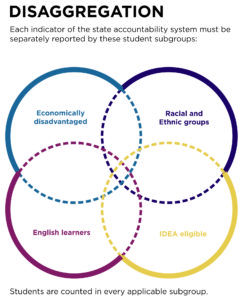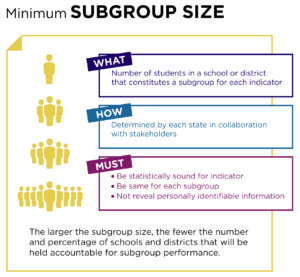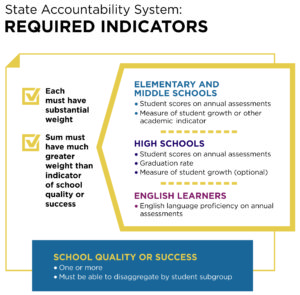 January 2017
January 2017
A collaborative publication of the Center for Parent Information and Resources (CPIR) and The Advocacy Institute
Welcome to Section 4 of the Stakeholder Guide to the Every Student Succeeds Act (ESSA), which focuses on ESSA’s requirements for each state’s accountability system.
The statewide accountability system will serve as the centerpiece of ESSA implementation. It is intended to improve student academic achievement and school success. It is essential that its individual elements are designed in a way that provides transparency and equity. The performance of students with disabilities might easily be masked if the accountability system is overly complex or extraordinarily simplistic. Stakeholders should focus their attention on the elements of the accountability system covered below.
- Indicators
- Graduation rates
- Subgroups of students
- Minimum subgroup size
- Annual measurement of achievement
- Long-term goals and measurements of interim progress
________________________
Not what you’re looking for?
See other sections of the guide.
________________________
Indicators
ESSA spells out the indicators that must be included in a statewide accountability system. The required indicators are described below.
ACADEMIC INDICATORS
Elementary and Middle Schools
- Student scores on annual state assessments
- Measure of student growth based on the annual assessments or other academic indicator
High Schools
- Student scores on annual state assessments (or another nationally recognized high school academic assessment)
- Graduation rate (the four-year adjusted cohort graduation rate)
- Measure of student growth based on the annual assessments (optional)
English Learners
- English language proficiency on the state’s annual assessment
NON-ACADEMIC INDICATOR
School Quality or Student Success
- Student performance on one or more indicators as determined by the state
While ESSA does not specify the amount of weight each of the indicators must be assigned within the accountability system, it does set some parameters. These are summarized in the graphic below.
Graduation Rates
ESSA requires states to use the four-year adjusted cohort graduation rate (ACGR) (Section 8101 (25)) for measuring the graduation rate indicator. The four-year adjusted cohort graduation rate is the number of students who graduate in four years with a regular high school diploma divided by the number of students who form the adjusted cohort for the graduating class.
From the beginning of 9th grade (or the earliest high school grade), students who are entering that grade for the first time form a cohort that is “adjusted” by adding any students who subsequently transfer into the cohort and subtracting any students who subsequently transfer out, emigrate to another country, or die.
The ACGR was first established through a 2008 regulation to ESEA. States were required to calculate graduation rates for all students and student subgroups and report to the U.S. Department of Education beginning in 2010-2011. The ACGR has now been incorporated into ESSA as the required method for calculating graduation rates and identifying high schools in need of improvement.
Subgroups of Students (Section 1111 (c)(2))
 ESSA requires information on each of the accountability system indicators to be disaggregated (or broken out) for the following subgroups of students:
ESSA requires information on each of the accountability system indicators to be disaggregated (or broken out) for the following subgroups of students:
- economically disadvantaged students
- students from each major racial/ethnic group
- children with disabilities as defined under IDEA
- English learners
This disaggregation is designed to allow the performance and expectations of historically low-performing groups of students to be visible to the public so that gaps are identified. However, subgroup data are used for accountability only when the number of students in the subgroup meets or exceeds the “minimum” number of students set by the state. (Section 1111 (c)(3))
The requirement for states to set a minimum number of students—frequently called “n” size—is designed to ensure that the information reported for student subgroups is statistically sound and reliable and does not reveal personally identifiable information. ESSA requires that the minimum group size set by the state be the same for all student subgroups. In other words, the minimum group size for reporting proficiency rates on state assessments can’t be set at 10 for economically disadvantaged students and 20 for IDEA students.
Minimum Subgroup Size
 The setting of minimum subgroup sizes is a critical component of the statewide accountability system, particularly for students with disabilities. Past studies, such as The Inclusion of Students with Disabilities in School Accountability Systems, have shown that the minimum subgroup size many states established under their No Child Left Behind accountability system resulted in many—and in some states, most—schools not being held accountable for the students with disabilities subgroup.
The setting of minimum subgroup sizes is a critical component of the statewide accountability system, particularly for students with disabilities. Past studies, such as The Inclusion of Students with Disabilities in School Accountability Systems, have shown that the minimum subgroup size many states established under their No Child Left Behind accountability system resulted in many—and in some states, most—schools not being held accountable for the students with disabilities subgroup.
Now, the reauthorized ESSA requires states to set the minimum group size, including:
- the number of students in a school or district that constitutes a subgroup (the “what“) for each indicator; and
- “how” the state determined the minimum group size, including “how” it collaborated with teachers, principals, other school leaders, parents, and other stakeholders when determining the minimum number. (Section 1111 (c)(3)(A)(ii))
Additionally, the ESSA includes several “MUSTs” about minimum subgroup size, including that it must:
- be statistically sound for each indicator;
- be the same for each student subgroup; and
- NOT reveal personally identifiable information.
The larger the subgroup size, the fewer the number and percentage of schools and districts that will be held accountable for subgroup performance.
Back to top
Parent Center Action Items
Stakeholders should expect that the state, in the process of determining the minimum subgroup sizes to be used for each indicator, will provide detailed information about the impact of the proposed subgroup size, including:
- the number and percentage of students in each subgroup for whose results schools would not be included in the state’s accountability system; and
- the number and percentage of schools in the state that would not be held accountable for student subgroup performance, including the subgroup of students with disabilities.
Annual Measurement of Achievement (Section 1111(c)(4))
ESSA maintains the requirement that all schools administer their annual assessments to at least 95% of all students and 95% of all students in each subgroup, measured separately for reading or language arts and math.
While ESSA maintains this important provision, originally established under No Child Left Behind to ensure that low-performing students were not routinely excluded from assessments, states will now determine the level of importance this measurement will be assigned within the overall statewide accountability system.
This is a significant change from No Child Left Behind, which required schools to achieve the 95% participation requirement or be rated as not achieving adequate yearly progress. In other words, schools first needed to meet this important testing participation threshold before the proficiency of its students was considered in the accountability system.
The participation rates must be reported at the school, district, and state level. ESSA prescribes the manner in which the participation rate is to be calculated for all students and for all students in each subgroup. Once a school falls below the testing threshold of 95% of students in the grades assessed, the students not participating must be counted as non-proficient in the all-student and student subgroups when calculating achievement rates on academic assessments. This provision should serve as a deterrent from schools excluding large groups of students since a participation rate below 95% will have a negative impact on the proficiency rate of students.
Parent Center Action Items
The determination of how the annual measurement of achievement will be treated in the state accountability system is critical, particularly for students with disabilities. Ideally, stakeholders should advocate for a significant degree of importance for this measurement in the overall accountability system so as not to allow schools to exclude large numbers or entire subgroups of students and still achieve a positive overall rating.
The actions that a state will undertake to deal with schools that fall below the 95% participation requirement are also critical. Stakeholders should work to ensure that states have in place specific actions that will be put in motion when a school fails to meet the participation requirement.
Long-Term Goals and Measurements of Interim Progress (Section 1111 (c)(4)(A)
States must establish ambitious long-term goals and measurements of interim progress for all students and for each subgroup of students for, at a minimum, improved academic achievement, as measured by grade–level proficiency on the annual academic assessments in reading or language arts and high school graduation rates.
The time period for the long-term goals must be the same for all students and for each subgroup of students in the state. It must take into account the improvement necessary to make significant progress in closing statewide proficiency and graduation rate gaps for subgroups of students who are behind. In other words, the interim progress for groups of students that are lower-achieving would require greater rates of improvement. Furthermore, the multi-year timeline to achieve the long-term goals must be the same for all students and for each subgroup of students.
States must also set long-term goals and interim measures of progress for increases in the percentage of English learners who make progress in achieving English proficiency, as defined by the state and as measured by the state’s ELP assessments.
ESSA does not define “significant progress” in closing proficiency and graduation rate gaps. So, while the timeline for progress must be the same for all students and student subgroups, the expectations can look substantially different between subgroups.
An example of proficiency gaps on state assessments in reading or English language arts might look something like this:
Standard Exceeded
Children with disabilities | 3%
Children w/out disabilities | 18%
Proficiency gap | 15%
Standard Met
Children with disabilities | 9%
Children w/out disabilities | 30%
Proficiency gap | 21%
Standard Nearly Met
Children with disabilities | 18%
Children w/out disabilities | 26%
Proficiency gap | 8%
Standard Not Met
Children with disabilities | 70%
Children w/out disabilities | 26%
Proficiency gap | 44%
Parent Center Action Items
Proficiency and Graduation Goals | States will likely set proficiency goals for reading or language arts and math based on the proficiency rates that were achieved by each subgroup in the most recent administration of the state assessments. Graduation goals will also likely be based on the most recent graduation rates as measured by the 4-year adjusted cohort graduation rate (ACGR).
Therefore, it will be important for stakeholders to know these latest results and the gaps between students with disabilities and those without disabilities. Only by knowing this information can the goals be evaluated as to whether they result in “significant progress” in closing the gaps.
To find out the proficiency rates and graduation rates for your state, visit:
eddataexpress.ed.gov
Helpful resource | Check out the CPIR webinar, Using Data for Collaboration and Advocacy, at:
http://www.parentcenterhub.org/repository/webinar15-data/
_________________________
Authorship | This guide has been produced in a partnership between the Center for Parent Information and Resources (CPIR) and The Advocacy Institute under a cooperative agreement from the U.S. Department of Education Office of Special Education Programs. The Center for Parent Information and Resources is a project of the Statewide Parent Advocacy Network, Inc.
_________________________
Index of Sections in the Stakeholder Guide to the ESSA
The Stakeholder Guide to the ESSA is presented in separate sections. Which section would you like to read now?
1 | Background, Structure of the ESSA, Implementation Timeline, State Plans, Stakeholder Engagement
2 | Academic Content Standards and Achievement Standards
4 | Statewide Accountability System (You’re already here!)


